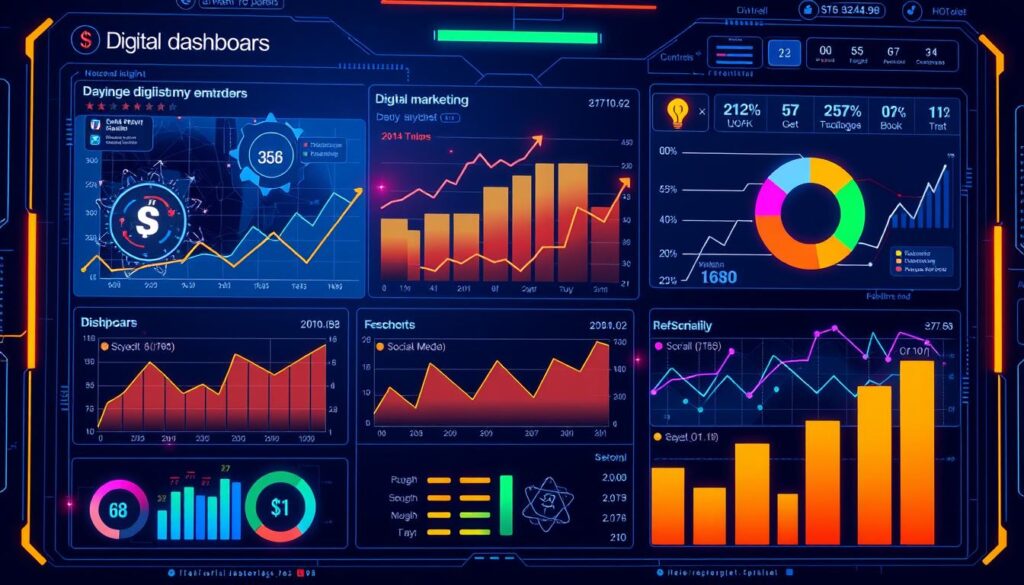We’re excited to share our knowledge on measuring digital marketing ROI. This is key to understanding how well our marketing works. Let’s look at an example: a company spends $10,000 on marketing and makes $126,000, showing a 1160% ROI!
In the digital marketing world, knowing how to measure ROI is vital. It helps us grow our business. By watching things like website visits, how many people buy, and how much ads cost, we learn a lot. This helps us improve our marketing plans.
Table of Contents
Key Takeaways
- Measuring digital marketing ROI is essential for business sustainability and growth
- Tracking ROI helps inform marketing strategies and allocate budget effectively
- Key performance indicators (KPIs) provide real-time insights into campaign performance
- Effective resource allocation can be achieved by identifying campaigns with the highest ROI
- By tracking ROI, businesses can make informed decisions about investing in new marketing channels or optimizing existing ones
- Understanding the lifetime value of the customer and average sale per industry is critical for measuring digital marketing ROI
- Creating aligned marketing assets with messaging, content, and creative elements that resonate with the audience is essential for success
Understanding Digital Marketing ROI Fundamentals
Knowing the basics of digital marketing ROI is key for businesses to make smart choices. It helps them improve their marketing plans. In the digital marketing world, it’s vital to understand how to measure success and track ROI to grow the business.
Digital marketing aims to get the most from marketing spending. By looking at website traffic, conversion rates, and ad spend returns, we learn a lot. This knowledge helps us make better marketing choices based on solid data.
Important parts of digital marketing ROI include:
- Cost per Lead (CPL)
- Cost per Acquisition (CPA)
- Lead Close Rate
- Click-through Rate (CTR)
- Return on Ad Spend (ROAS)
By knowing these parts and tracking ROI well, we can see how our marketing is doing. This helps us find and fix problems, leading to business growth.
Essential Metrics for Measuring Digital Marketing ROI
Measuring digital marketing ROI is key for businesses to make smart choices. We track important marketing metrics and digital campaign data. Key metrics include average order value, average lead value, and return on ad spend.
Tracking these metrics gives us insights into our campaign’s success. We can make decisions based on data to improve our marketing. For instance, we use cost per lead and cost per acquisition to check our campaign’s efficiency.
Here are some essential metrics for measuring digital marketing ROI:
- Average order value
- Average lead value
- Return on ad spend
- Cost per lead
- Cost per acquisition
By tracking these metrics and using digital campaign measurement, we can see how well our marketing works. This helps us find and fix problems, leading to business growth.
| Metric | Description |
|---|---|
| Average order value | The average value of customer orders |
| Average lead value | The average value of leads generated |
| Return on ad spend | The revenue generated from ad spend |
Setting Up Your ROI Tracking Framework
To measure your digital marketing campaigns’ success, setting up an ROI tracking framework is key. You need to pick the right analytics tools, set up measurement parameters, and create custom tracking solutions. This way, you can accurately see the ROI of your marketing efforts and make smart decisions to improve your strategies.
Choosing the Right Analytics Tools
Choosing the right analytics tools is critical for ROI tracking. Tools like Google Analytics, Adobe Analytics, and Mixpanel are popular. They give you insights into website traffic, conversion rates, and customer behavior. This helps you see how well your marketing campaigns are doing and make better choices.
Establishing Measurement Parameters
Setting up measurement parameters is essential for ROI tracking. You need to define goals like conversions, lead generation, or sales. Also, track important metrics like cost per lead and return on ad spend. This lets you accurately measure your marketing campaigns’ success and find ways to get better.
Creating Custom Tracking Solutions
Creating custom tracking solutions helps you understand your customers better. You can set up custom events like form submissions or phone calls. Tracking customer interactions across different touchpoints gives you deeper insights. This way, you can see how effective your marketing campaigns are and make better decisions to improve them.
The Science Behind ROI Calculation Methods
Understanding the science of ROI calculation is key for businesses to make smart choices. It helps in optimizing marketing strategies. Knowing how to measure marketing effectiveness is vital for growth.
The simple ROI formula is: (Sales Growth – Marketing Cost) / Marketing Cost = ROI. For instance, if sales rose by $1,000 and the campaign cost $100, the ROI is 900%. This formula helps us see how well our marketing works and make better choices.
Here are some important points for ROI calculation:
- A high ROI means a marketing campaign was successful
- The Campaign Attributable ROI formula is: (Sales Growth – Average Organic Sales Growth – Marketing Cost) / Marketing Cost = ROI
- Even if sales don’t grow, avoiding losses can be seen as a success
By understanding ROI calculation, we can see how well our marketing does. This helps us find and fix areas that need work. For more on improving your marketing, visit this link.
| Formula | Description |
|---|---|
| Simple ROI | (Sales Growth – Marketing Cost) / Marketing Cost = ROI |
| Campaign Attributable ROI | (Sales Growth – Average Organic Sales Growth – Marketing Cost) / Marketing Cost = ROI |
Advanced Techniques for Measuring Digital Marketing ROI
In the world of digital marketing, it’s key to measure how well our efforts are doing. Advanced methods help us understand our marketing better. This way, we can make smart choices based on data.
For businesses, knowing how well marketing works is vital. It helps us decide where to spend our money wisely. By looking at website traffic, conversion rates, and ad spend returns, we learn a lot. This knowledge helps us improve our marketing plans.
Multi-Channel Attribution Models
These models show us how customers move through different marketing channels. They help us see the value of each step. This way, we can better plan our marketing budget across various channels.
Customer Lifetime Value Analysis
This analysis tells us how much money each customer brings in over time. It shows us how well our marketing is working. This info helps us keep and attract more customers.
Cross-Platform Performance Tracking
This method lets us see how well our marketing does on different platforms. It includes social media, email, and search engines. Knowing which platforms work best helps us spend our budget wisely.
By using these advanced techniques, we can really understand our marketing. Whether it’s checking how well marketing works or tracking its performance, data is key. It helps us grow our business and reach our goals.
Common Challenges in ROI Measurement
Measuring digital marketing ROI can be tough. Businesses often struggle to track and measure ROI. It’s key to understand roi tracking and its role in business growth.
Challenges include tracking each customer touchpoint and standardizing ROI metrics. Also, tracking across different platforms can be inconsistent. To tackle these, set clear goals and use data analytics tools. Attribution modeling helps assign credit to each touchpoint. For more on marketing campaign success, visit this link.
Knowing these challenges helps us track marketing success. It lets us find areas to improve. This leads to growth. Key steps include setting goals, using analytics, and attribution modeling.
- Setting clear goals and metrics before campaign launch
- Using data analytics tools to track customer interactions
- Employing attribution modeling to accurately assign credit to touchpoints in the customer journey
By tackling these challenges, we can make our marketing better. This helps us reach our business goals.
| Challenge | Solution |
|---|---|
| Tracking the impact of each touchpoint in the customer journey | Use data analytics tools to track customer interactions |
| Lack of standardization in defining ROI metrics | Set clear goals and metrics before campaign launch |
| Inconsistent tracking across different platforms | Employ attribution modeling to accurately assign credit to touchpoints in the customer journey |
Optimising Campaign Performance Through Data Analysis
We think it’s key for businesses to boost their ROI by optimising campaign performance. Digital marketing analysis helps us spot where we can do better. For instance, a company that spends $10,000 on marketing and makes $126,000, gets a 1160% ROI. This shows how important it is to track our campaign’s success.
Identifying Performance Patterns
- Analysing website traffic and conversion rates to identify trends and patterns
- Using data analytics tools to track customer interactions and behaviour
By spotting performance patterns, we learn a lot about our campaigns. It’s vital to understand how to measure marketing success and track ROI for business growth. For tips on measuring campaign success, check out this link. It can help you boost your marketing and business productivity.
Implementing Data-Driven Adjustments
After spotting patterns, we can make smart changes to our campaigns. This might mean adjusting our budget, targeting better audiences, or improving our landing pages. Digital marketing analysis and ROI tracking help us see what works and what doesn’t.
Measuring Optimisation Impact
To see how our changes are working, we track important metrics. This includes website traffic, conversion rates, and ROI. By doing this, we can make better decisions to keep improving our marketing.
Tools and Technologies for ROI Tracking
We think it’s key for businesses to track ROI to make smart choices and improve their marketing plans. To achieve this, the right tools and technologies are needed. These include marketing metrics and ROI tracking software. Recent stats show that just over half of marketers are tracking ROI well. Also, 57% of marketers use leads to check if their marketing is working.
Popular tools for tracking ROI include Google Analytics, which is free and tracks important metrics like top traffic sources and conversions. Cyfe offers a free version and lets you monitor your dashboard in your own way. Kissmetrics focuses on linking data to real people and tracking how they use devices. Email marketing is also great for tracking ROI, as it lets businesses see how well their campaigns are doing.
When picking a tool for ROI tracking, cost and features are key. For example, Ruler Analytics starts at £199 a month. Cyfe has four plans, starting at $19 a month. Kissmetrics has plans like Growth ($500 a month) and Power ($850 a month). Using these tools helps businesses understand their marketing better and make better choices.
| Tool | Cost | Key Features |
|---|---|---|
| Google Analytics | Free | Top traffic sources, keywords, conversions |
| Cyfe | $19-$89 per month | Customizable dashboard monitoring |
| Kissmetrics | $500-$850 per month | Tying data to real people, tracking user behavior |
Integrating ROI Metrics with Business Objectives
We think it’s key to link ROI metrics with business goals. This helps businesses make smart choices and tweak their marketing plans. By watching things like website visits, social media activity, and email opens, we learn how well our campaigns are doing. This lets us make choices based on solid data to boost our digital marketing performance.
To link ROI metrics with business goals, we must match our marketing aims with business KPIs. We set clear, measurable targets, like more website visitors or higher sales. Using tools like cost per lead and cost per sale, we see how well our marketing works and where we can get better.
Aligning Marketing Goals with Business KPIs
It’s vital to match marketing goals with business KPIs to see if our marketing is working. By looking at things like customer lifetime value (CLV) and return on investment (ROI), we understand how well our marketing does. This helps us make smart choices to better our strategies.
Creating Actionable ROI Reports
It’s important to make ROI reports that lead to action. By using metrics like website visits, social media activity, and email opens, we make detailed reports. These reports give us key insights into how our campaigns are doing. Here are some important metrics to include in your ROI report:
- Website traffic and engagement metrics
- Social media metrics, such as engagement rates and reach
- Email marketing metrics, including open rates and conversion rates
- Paid advertising metrics, such as cost per click and return on ad spend
By linking ROI metrics with business goals and making useful ROI reports, we can fine-tune our marketing plans. This means always checking and analyzing our marketing’s performance. We look for ways to get better and make choices based on data to improve our measuring digital marketing roi.
| Metric | Description |
|---|---|
| Website Traffic | The number of visitors to your website |
| Social Media Engagement | The level of engagement with your social media content |
| Email Open Rates | The percentage of email recipients who open your emails |
Future-Proofing Your ROI Measurement Strategy
We think it’s key for businesses to keep up with the competition by future-proofing their ROI strategy. By using measurement programs and learning from tests, brands can see up to 75% more ROI. We must change how we target and measure because of privacy issues and the loss of third-party cookies.
By linking measurement to marketing goals with clear KPIs, we lay a solid base for a complete measurement system. A strong, flexible analytics framework helps us handle changes, connect better with our audience, and improve our performance. To keep our ROI strategy strong, we must build skills in content creation, managing different channels, and using automation and AI.
Emerging Technologies and Trends
New tech like AI and machine learning is changing how we track ROI and measure digital marketing. These tools help us understand our customers better and make our marketing more effective. Key steps to keep our ROI strategy up-to-date include:
- Identifying KPIs and making measurement omnichannel
- Balancing brands and performance
- Experimenting and adapting to changing market conditions
Adapting to Market Changes
To keep up with market shifts, we need a 5-year plan for channel investment. We should allocate resources based on audience growth. We also need to create future customer profiles, thinking about how new norms might shape culture in 5-10 years.
By measuring impact fully and considering community goodwill, brand sentiment, and cultural impact, we can build a strong ROI strategy. This strategy will help our business grow.
Best Practices for Continuous ROI Improvement
To keep improving ROI, it’s key to regularly check your digital marketing and calculate ROI. This lets you spot where you can do better and tweak your marketing plans. By watching things like how many people convert, the cost per lead, and the cost per acquisition, you can see how well your campaigns are doing.
- Conducting regular digital marketing analysis to identify areas of improvement
- Using roi calculation to optimize marketing strategies and improve ROI
- Tracking KPIs such as conversion rates, cost per lead, and cost per acquisition
By sticking to these tips, businesses can keep boosting their ROI and hit their marketing targets. Remember, a positive ROI means you’re making more money than you spend. A negative ROI means you’re losing money. With digital marketing analysis and ROI calculation, businesses can make smart choices to better their marketing and ROI.
Conclusion: Mastering Digital Marketing ROI Measurement
We think it’s key for businesses to get good at measuring digital marketing ROI. This helps them make smart choices and tweak their marketing plans. By watching things like conversion rates and cost per lead, they can see how well their campaigns are doing. This lets them make choices based on solid data.
Knowing the ROI of marketing campaigns is vital for businesses. They can use numbers like return on ad spend (ROAS) and customer lifetime value (CLV) to check how well their marketing is working. For example, if a company spends £10,000 on ads and makes £126,000, their ROI is 1160%. This shows their campaign was a big win.
By getting better at measuring digital marketing ROI, businesses can fine-tune their marketing, boost their ROI, and hit their goals. We urge businesses to keep an eye on how their marketing is doing, spot what needs work, and use data to make their strategies better. With tools like Google Analytics and HubSpot, they can really understand their customers and craft more effective marketing plans.
FAQ
What is digital marketing ROI and why is it important?
Digital marketing ROI shows how much money a campaign makes compared to its cost. It helps businesses see if their marketing is working. This way, they can make better choices to get more from their marketing efforts.
How do I calculate digital marketing ROI?
To find digital marketing ROI, divide the campaign’s revenue by its cost. Then, multiply by 100 to get a percentage. Tools like Google Analytics can help you do this and see how well your campaigns are doing.
What are the key components of digital marketing ROI?
The main parts of digital marketing ROI are the campaign’s cost, the revenue it brings in, and the return on investment. Knowing these well helps you understand your campaigns’ success and make smart decisions.
What are the essential metrics for measuring digital marketing ROI?
Important metrics include conversion rates, click-through rates, and cost per acquisition. Also, look at website traffic and social media engagement. These help you see how your campaigns are doing and make better choices.
How do I set up an ROI tracking framework?
First, pick the right analytics tools. Then, set up how you’ll measure things. Use tools like Google Analytics to track goals, events, and conversions. This helps you see how your campaigns are doing.
What are the advanced techniques for measuring digital marketing ROI?
Advanced methods include looking at how different channels work together and understanding customer behaviour. These help you make better decisions to improve your marketing.
What are the common challenges in ROI measurement?
Challenges include tracking ROI and figuring out which campaigns bring in revenue. Use the right tools and set up a strong tracking system to overcome these.
How do I optimise campaign performance through data analysis?
Look for patterns in your data, make changes based on it, and check if those changes worked. Use analytics tools to track your campaigns and find ways to improve.
What are the tools and technologies for ROI tracking?
Tools like Google Analytics and Adobe Analytics help track your campaigns’ performance. They show you how well your marketing is doing.
How do I integrate ROI metrics with business objectives?
Align your marketing goals with your business’s KPIs. Use ROI metrics to guide your marketing and help achieve your business goals.
How do I future-proof my ROI measurement strategy?
Keep up with new technologies and trends. Adapt to changes in the market. This ensures your ROI strategy stays effective.
What are the best practices for continuous ROI improvement?
Regularly review your ROI metrics, find areas to improve, and make smart decisions. Use data to drive your marketing and keep improving your ROI.






